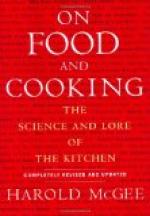Hot bread eaten with butter is still more unwholesome, for the reason that the melted grease fills up the pores of the bread, and further interferes with the action of the digestive fluids.
WHOLE-WHEAT AND GRAHAM BREADS.—The same general principles are involved in the making of bread with whole-wheat and Graham flours as in the production of bread from white flour. Good material and good care are absolutely essential.
Whole-wheat flour ferments more readily and rises more quickly than does white flour, hence bread made with it needs more careful management, as it is more liable to sour. The novice in bread-making should not undertake the preparation of bread with whole-wheat flour, until she has thoroughly mastered all the details of the art by practical experience, and can produce a perfect loaf from white flour.
Breads from whole-wheat and Graham flours require less yeast and less flour than bread prepared from white flour. A slower process of fermentation is also advantageous.
Such breads will be lighter if at least one third white flour be employed in their manufacture. When the bread is made with a sponge, this white flour may be utilised for the purpose. Thus the length of time the whole-wheat flour will be undergoing fermentation will be somewhat lessened, and its liability to become sour diminished. This plan is a preferable one for beginners in bread-making.
Graham and whole-wheat flour breads must be kneaded longer than white-flour bread, and require a hotter oven at first and a longer time for baking. Much Graham and whole-wheat bread is served insufficiently baked, probably owing to the fact that, being dark in color, the crust appears brown very soon, thus deluding the cook into supposing that the loaf is well baked. For thorough baking, from one to one and a half hours are needed, according to the size of the loaf and the heat of the oven.




